As the modern logistics industry advances, the demands for lighting have shifted to require high-quality, efficient, and energy-saving solutions. Logistics centers are large, high-ceiling spaces or areas with tall racks accessed by forklifts, where accuracy and speed are paramount. In such environments, proper lighting that minimizes glare and flickering can help prevent accidents and ensure smooth operations. Clear visibility of package labels and delivery notes is also key to minimizing errors and boosting productivity.
LED high bay lights have emerged as the top choice for lighting in these settings. Their superior energy efficiency, long lifespan, and consistent light distribution make them indispensable for modern logistics facilities. In this article, we'll explore why LED high bay lights are essential for optimizing logistics operations.
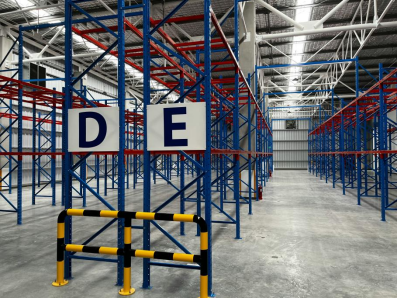
Understanding the Specific Lighting Needs of Logistics Centers
Logistics centers are large-scale facilities designed to store and move goods quickly and efficiently. These centers typically feature high ceilings and open spaces, with constant movement of goods and people. Effective lighting is important to ensure operations run smoothly, reduce accidents, and maintain productivity.
The specific lighting needs of logistics centers include:
1. Height of Installation: Since most logistics centers have high ceilings (often over 20 feet), lights need to be powerful enough to reach the ground without losing brightness or focus.
2. Even Light Distribution: Logistics centers require even light distribution to ensure every corner is properly illuminated, preventing dark spots that could lead to accidents or errors.
3. Continuous Operation: Many logistics centers operate 24/7, which requires lighting systems that are reliable, energy-efficient, and capable of long hours of continuous use without overheating.
4. Vertical Illumination: Most visual tasks in logistics warehouses occur on vertical surfaces, such as shelves or goods. Therefore, vertical illumination on racks and goods is crucial for determining overall lighting quality. Proper lighting should evenly cover entire aisles to prevent blind spots, reduce errors, and enhance safety and productivity.
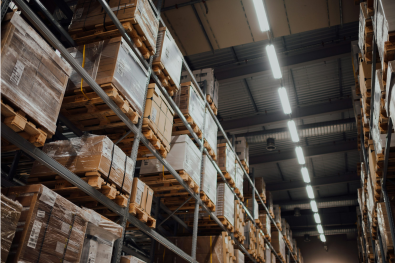
Exploring the Different Types of Light Bulbs for Logistics Applications
There are several lighting technologies available for logistics applications, each with its own set of advantages and drawbacks. Understanding the key differences between them will help you make an informed decision. Below, we explore the most common types of light bulbs used in logistics centers:
Metal Halide (MH) Bulbs
Metal halide bulbs provide high brightness and good color rendering but are energy-inefficient, have a short lifespan (15,000-20,000 hours), and generate significant heat.
Fluorescent Bulbs (T5 and T8 Tubes)
Fluorescent bulbs are cost-effective and moderately efficient but offer lower brightness for high ceilings, contain mercury, and have a shorter lifespan (around 20,000 hours).
High-Pressure Sodium (HPS) Bulbs
HPS bulbs are energy-efficient and long-lasting (24,000 hours), but they have poor color rendering with a yellow tint and a slow warm-up time.
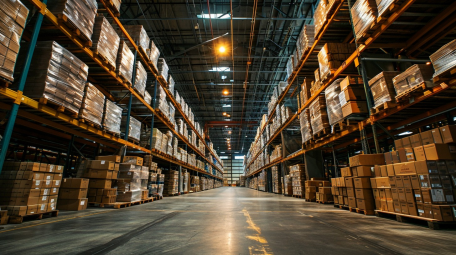
Halogen Bulbs
Halogen bulbs offer instant brightness and good light quality but have a short lifespan (2,000-6,000 hours), high heat output, and are less energy-efficient.
LED High Bay Lights
LEDs are highly energy-efficient, long-lasting (50,000-150,000 hours), provide instant full brightness, emit little heat, and offer excellent light quality, making them ideal for logistics centers.
Given the scale of logistics centers, where hundreds or even thousands of lights may be in use, the benefits of LED lighting are multiplied. By switching to LED high bay lights, logistics centers can save on both energy costs and maintenance efforts, while also benefiting from superior light quality.
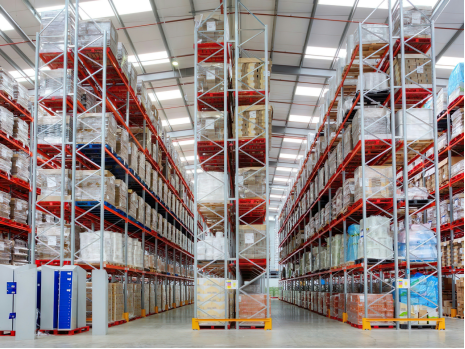
Key Advantages of LED High Bay Lights in Logistics Operations
The decision to switch to LED high bay lights offers logistics centers a host of benefits that directly impact their operations. Some of the most important advantages include:
1. Enhanced Safety: Bright, clear light improves visibility, reducing the risk of accidents and injuries. In high-traffic areas, such as loading docks or warehouse floors, this enhanced visibility can prevent costly mistakes and ensure a safer work environment.
2. Energy Savings: LED lights use significantly less electricity than traditional lighting options. Logistics centers can reduce their energy bills by up to 80% by using LED high bay lights, contributing to long-term savings and a reduced environmental footprint.
3. Reduced Maintenance: With their long lifespan, LED lights require fewer replacements, which means less downtime for lighting maintenance and lower labor costs. This is particularly beneficial in facilities that operate around the clock.
4. Instant Brightness: Unlike some traditional lights that require warm-up time, LEDs provide instant illumination at full brightness, ensuring that there is no delay in lighting when operations start or when lights are turned on after a power outage.
5. High Durability: LED lights are more resistant to shock, vibration, and environmental factors like dust and moisture, making them highly reliable in tough conditions.
6. Saving Costs and Environmentally friendly: LED lights reduce operational costs through their energy efficiency, consuming up to 80% less power than traditional bulbs. Their long lifespan also minimizes maintenance and replacement expenses. Besides, LEDs are environmentally friendly, as they contain no toxic materials like mercury and have a lower carbon footprint, meet the needs of sustainability.
By leveraging these advantages, logistics centers can improve both their efficiency and profitability, all while providing a better working environment for employees.
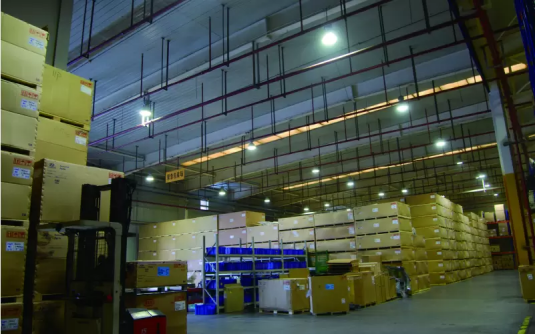
Critical Factors to Consider When Selecting High Bay Lights
When choosing the right LED high bay lights for your logistics center, it’s important to evaluate several factors to ensure optimal performance:
l Lumen Output: The brightness of the light, measured in lumens, is a critical factor. Logistics centers need high lumen output to ensure that the lighting is bright enough to cover large areas without shadows or dark spots.
l Beam Angle: The beam angle determines how widely the light is distributed. A wide beam angle is ideal for large, open spaces, while a narrower beam is better suited for focused areas that require more concentrated light.
l Color Temperature: Color temperature, measured in Kelvin (K), affects the quality of light. Cool white light (around 5000K) is generally preferred in logistics centers because it provides sharp, clear visibility, making it easier for workers to read labels, identify products, and navigate the space.
l Mounting Height: The height at which lights are installed plays a major role in how effectively they illuminate a space. High bay lights are typically installed at heights of 20 feet or more, so it’s essential to select lights that are powerful enough to provide sufficient light at these heights.
l Durability and Environmental Protection: Logistics centers can be harsh environments, with exposure to dust, moisture, and varying temperatures. Choosing lights with an appropriate IP (Ingress Protection) rating ensures that they can withstand these conditions and continue to operate reliably.
Considering these factors will help logistics centers select the right lighting solution that meets their specific needs while optimizing efficiency and performance.
Practical Use Cases of Sansi
Sansi is a leading manufacturer in the lighting industry. In collaboration with Mobis, the industry-leading automotive parts supplier, Sansi provided long-lasting, energy-efficient LED high bay lights for Mobis’base in Shanghai. The wireless lighting system enables warehouse developers and facility managers to achieve maximum energy savings, ultimately reducing energy costs by up to 50%.
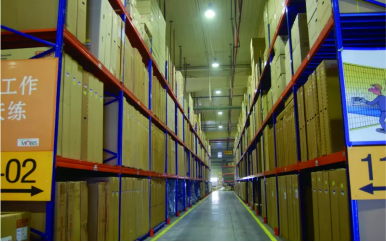
LED high bay lights are a crucial investment for logistics centers looking to enhance their operational efficiency. By understanding the specific lighting needs of logistics centers, selecting the right lights, and following best installation practices, you can optimize your lighting systems, reduce costs, and create a safer, more productive work environment.